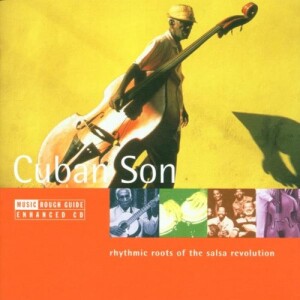 The Rough Guide to Cuban Son is a wide-ranging look at this music’s evolution from simple folk-based acoustic music to the big-band salsa of today. It features great son bands of the past as well as groups that still play traditional son, some of them pensioners who have recently returned to playing professionally after careers in the 1950s and 1960s, and some of them younger musicians who have continued to play son as a living art form.
The Rough Guide to Cuban Son is a wide-ranging look at this music’s evolution from simple folk-based acoustic music to the big-band salsa of today. It features great son bands of the past as well as groups that still play traditional son, some of them pensioners who have recently returned to playing professionally after careers in the 1950s and 1960s, and some of them younger musicians who have continued to play son as a living art form.
Typical of the Rough Guide CDs I’m familiar with, this one is an exceptional package. The documentation and artwork are professional and well written, adding greatly to the listener’s appreciation. The music lasts a full 71 minutes, giving great value for the money and a wide range of acts.
The CD opens with the infections mid-tempo son “En Guantanamo” by the Septeto Nacional. This is a group that has been around since the 1920s when it was founded by Ignacio Pineiro, who was the first to add a trumptet to a son band and make it a septet.
The CD also includes tracks from Beny More’s popular big-band group of the 1950s; Orquesta 40, on an undated track from sometime in the 50s in the charanga style (which adds piano and sometimes more horns to the sextet); Orquesta Aragon, another charanga group from the ’50s; Nico Saquito, who composed and performed from the ’30s into the ’80s; Septeto Habanero, contemporaries of the early years of the Septeto Nacional; and Maria Teresa Vera, a guitarist and singer who performed as a duo with Lorenzo Hierrequelo from the late ’30s into the early ’60s.
Also included is a track from Los Jubilados, a contemporary group of mostly retirees from the eastern port city of Santiago, who have their own CD out on Corason.
At the other end of the spectrum, there are tracks from contemporary big band groups that play a mix of salsa and son, including Jesus Alemany’s Cubanismo!, the Afro-Cuban All Stars, Vieja Trova, and Los Van Van, some of which add electric instruments and other elements of salsa to the rhythms and styles of son.
In between are several modern groups playing more traditional son, including Canambu, Familia Valera Miranda, and Sierra Maestra.
Some of the standout tracks include the Familia Valera Miranda’s “Chan Chan,” written in the 1950s by Compay Segundo; Maria Teresa’s “Eso no es na,” delivered in her trademark voice that is equal parts black coffee and cigar smoke; the Septeto’s opening track; and the conga-style “El Tren,” complete with bird-like whistling and vocal sound effects of a train. But everything about this disc is top-notch, and it’s a good place to start for someone who wants to move beyond the “Buena Vista” group but doesn’t know where to start among the profusion of recordings available today.
(World Music Network, 2000)
